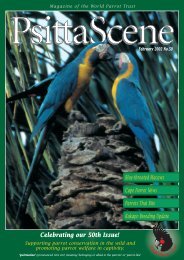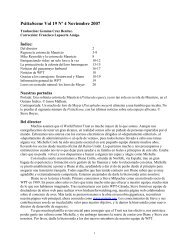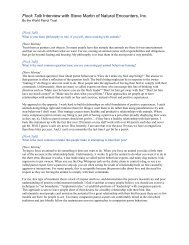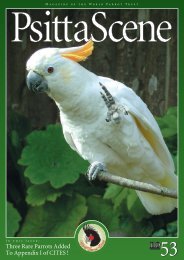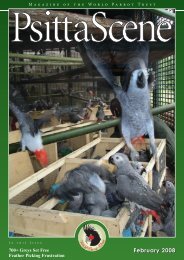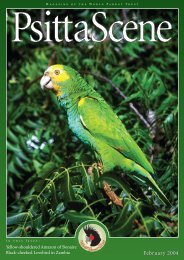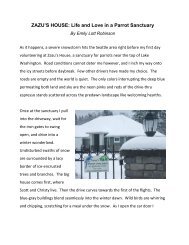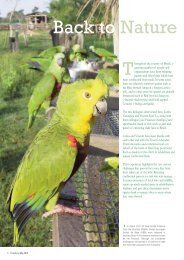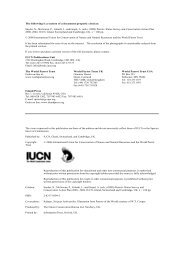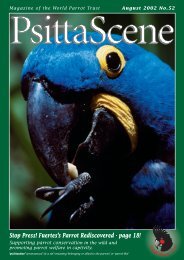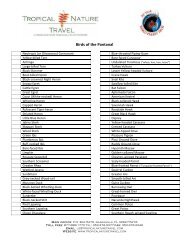Download - World Parrot Trust
Download - World Parrot Trust
Download - World Parrot Trust
Create successful ePaper yourself
Turn your PDF publications into a flip-book with our unique Google optimized e-Paper software.
near Canberra. Thanks to the<br />
support from both the Gowlands<br />
and Adelaide Zoo, the results of<br />
these trials will place myself and<br />
Richard in an excellent position<br />
to decide which approach to<br />
take with wild birds.<br />
I have had two small field<br />
sessions so far this year; one in<br />
January and another, much<br />
wetter one in April. The aims of<br />
these two trips were: (a) to<br />
choose and then familiarise<br />
myself with a study area; (b) to<br />
start finding some nest sites;<br />
and (c) organise some<br />
accommodation. The main area I<br />
will be concentrating my efforts<br />
upon is a large patch of tropical<br />
grassy woodland which has<br />
several rainforest-boarded<br />
creeks passing through it. It also<br />
has a relatively large population<br />
of palm cockatoos, and several<br />
known nests that Queensland<br />
Parks and Wildlife ranger Daryn<br />
Storch worked on several years<br />
ago. Daryn showed me these<br />
and other nests in the April field<br />
trip. The last objective - to find<br />
accommodation - was fulfilled<br />
by the generous offer of local<br />
well-known naturalist Brian<br />
Venables who has kindly offered<br />
his house at Cape Weymouth.<br />
To come....<br />
The first priority of the current<br />
field session (which has only<br />
just begun) will be to trap and<br />
fit radio-transmitters to as many<br />
palm cockatoos as possible.<br />
We’re hoping to catch about 10<br />
adults while they’re feeding on<br />
fallen fruits, using a flip-trap<br />
specially built for the purpose at<br />
the ANU. It is possible that palm<br />
cockatoos may be moving<br />
around, following the fruiting of<br />
various trees. By catching birds<br />
feeding in areas which have a<br />
seasonal supply of food, we<br />
should be able to find out<br />
whether or not these birds are<br />
either residents of the place<br />
where they are caught, or do<br />
indeed move over large areas to<br />
forage. We are also hoping to fit<br />
transmitters to breeding birds<br />
that we trap in the vicinity of<br />
nests. This will be important to<br />
determine the home range and<br />
extent of any foraging forays<br />
that breeding birds make.<br />
Eventually, I hope to use these<br />
data to understand the<br />
relationship between foraging<br />
effort and breeding success.<br />
So, in this first report of the<br />
Cape York palm cockatoo<br />
research project, I am pleased to<br />
announce that things are finally<br />
up and running. With this<br />
progress, especially after<br />
achieving my aims from the first<br />
two field trips, I’m hoping that it<br />
is a sign of great things to come.<br />
Further Reading<br />
Brown, D. M. and Toft, C. A.<br />
(1999). Molecular systematics<br />
and biogeography of the<br />
cockatoos (Psittaciformes :<br />
Cacatuidae). Auk. 116:141-157.<br />
Forshaw, J.M. and Cooper, W.T.<br />
(1981). Australian <strong>Parrot</strong>s.<br />
Second Edition. Lansdowne<br />
Editions. Melbourne.<br />
Palm Cockatoo is anaesthetised before radio transmitter is fitted.<br />
Photos: Steve Murphy<br />
How you can help our Palm<br />
cockatoo project:<br />
The <strong>World</strong> <strong>Parrot</strong> <strong>Trust</strong> made a commitment to find A$30,000<br />
(approx. £12,500 or US$20,000) over three years. Our fourth<br />
payment of A$5,000 is due in January 2000. Half of this will be<br />
provided by our Australian branch, but the rest, about £1,050,<br />
must come from our UK funds. Any contributions towards this,<br />
perhaps from owners of Palm Cockatoos, or members who<br />
simply want to help this excellent project, would be very<br />
welcome. Please send cheques to our UK office.<br />
How you can help Pesquet’s <strong>Parrot</strong><br />
(See pages 2 and 3)<br />
WPT is not currently contributing towards the work on Pesquet’s<br />
<strong>Parrot</strong> in Papua New Guinea. This is part of a major long term<br />
program funded and carried out by Wildlife Conservation Society<br />
in PNG. However, when corresponding with Andrew Mack and his<br />
associate Dhananjaya Katju, we asked if there were something we<br />
could do to help, and they replied asking if we could supply a<br />
good spotting scope and a pair of Leica 10x42 waterproof<br />
binoculars. The latter are listed at £689 ($1,100), and the scope<br />
would be similar. So here’s an opportunity for a WPT member to<br />
help fund these essential items. Also, if anyone has any unwanted<br />
binoculars, please send them to our UK or USA offices - they are<br />
always welcome in any of our field projects. Many thanks.<br />
PsittaScene Volume 11, No 4, November 1999 ■ 13




